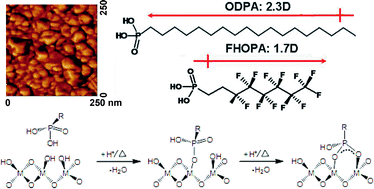Sputter-deposited BaTiO3 thin films have been modified with an alkylphosphonic acid and a partially-fluorinated alkylphosphonic acid in order to model the surface composition of similarly modified BaTiO3 nanoparticles. We present here the surface characterization of these modified films by a combination of X-ray photoelectron spectroscopy (XPS) and UV-photoelectron spectroscopy (UPS). BaTiO3 layers of average thicknesses ca. 2 nm were prepared by radio frequency (rf) magnetron sputter deposition on Ag films, to avoid charging effects during XPS/UPS characterization. Octadecylphosphonic acid (ODPA) and 3,3,4,4,5,5,6,6,7,7,8,8,8-tridecafluorooctyl phosphonic acid (perfluorohexyloctyl phosphonic acid, FHOPA), molecules with quite different molecular dipole moments, were chemisorbed from solution to the BaTiO3 surface. Polarization-modulation infrared reflection-absorption spectroscopy (PM-IRRAS) of the modified BaTiO3 films indicated bidentate bonding of the alkylphosphonic acid to the oxide. Modification of the BaTiO3 surface with the partially-fluorinated alkylphosphonic acid (versus the normal alkylphosphonic acid) significantly changes the BaTiO3 interface dipole as revealed by UPS/XPS measurements, which, in turn, changes the frontier orbital offsets between the oxide and the organic modifier.


 Please wait while we load your content...
Please wait while we load your content...